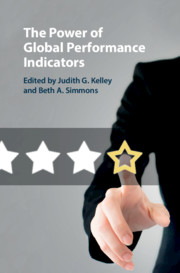Book contents
- The Power of Global Performance Indicators
- The Power of Global Performance Indicators
- Copyright page
- Contents
- Figures
- Tables
- Contributors
- Preface
- 1 Introduction
- Part I Ratings, Rankings, and Regulatory Behavior
- 2 The Power of Ranking
- 3 Blacklists, Market Enforcement, and the Global Regime to Combat Terrorist Financing
- 4 The Power of Indicators in Global Development Policy
- Part II The Normative Influence of Ratings and Rankings
- Part III Beyond and Within State
- Part IV Skeptical Voices
- Index
- Chapter 3: Appendices
- Chapter 4: Appendices
- Chapter 5: Appendix
- Chapter 6: Appendix
- Chapter 7: Appendix
- Chapter 8: Appendix
- Chapter 10: Appendix
- Chapter 11: Appendix
- Chapter 12: Appendix
- References
4 - The Power of Indicators in Global Development Policy
The Millennium Development Goals
from Part I - Ratings, Rankings, and Regulatory Behavior
Published online by Cambridge University Press: 28 February 2020
- The Power of Global Performance Indicators
- The Power of Global Performance Indicators
- Copyright page
- Contents
- Figures
- Tables
- Contributors
- Preface
- 1 Introduction
- Part I Ratings, Rankings, and Regulatory Behavior
- 2 The Power of Ranking
- 3 Blacklists, Market Enforcement, and the Global Regime to Combat Terrorist Financing
- 4 The Power of Indicators in Global Development Policy
- Part II The Normative Influence of Ratings and Rankings
- Part III Beyond and Within State
- Part IV Skeptical Voices
- Index
- Chapter 3: Appendices
- Chapter 4: Appendices
- Chapter 5: Appendix
- Chapter 6: Appendix
- Chapter 7: Appendix
- Chapter 8: Appendix
- Chapter 10: Appendix
- Chapter 11: Appendix
- Chapter 12: Appendix
- References
Summary
The Millennium Development Goals (MDGs) established the practice of indicator-based governance in international development. Yet, knowledge about their effectiveness in re-steering domestic policy remains limited. This chapter explores the extent and pathways of domestic policy adjustment to MDG 3, intended to promote gender equality. The study combines a comprehensive mapping of gender policy adoption in 15 Sub-Saharan African countries over 15 years with two case studies of the causal mechanisms of MDG adjustment in Kenya and Ethiopia. The principal findings are threefold: (1) there was considerable policy adjustment to MDG 3 across countries, pointing to the effectiveness of GPI-based development governance in re-steering policy priorities. (2) Despite the significant effects on policy goal-setting, further implementation remained limited, suggesting superficial behavioral change. (3) Process-tracing of the Kenyan and Ethiopian policy processes shows that behavioral change was primarily driven by the causal mechanisms of aid conditionality, social influence, and civil-society mobilization, all enabled through MDG intense performance monitoring. The decisive role of incentive-based mechanisms in generating policy change, and the limited elite socialization, explains why MDG 3 implementation was slow and contested. These findings have implications for debates about development GPIs and gender equality change and the reproduction of global power structures.
Keywords
- Type
- Chapter
- Information
- The Power of Global Performance Indicators , pp. 98 - 136Publisher: Cambridge University PressPrint publication year: 2020
References
- 3
- Cited by



